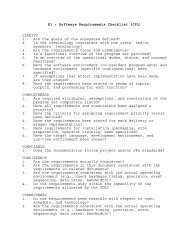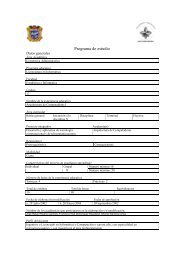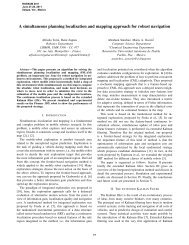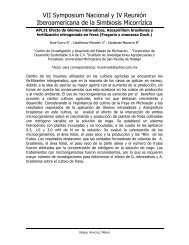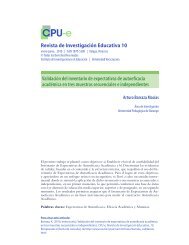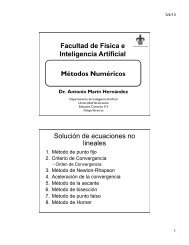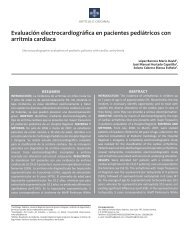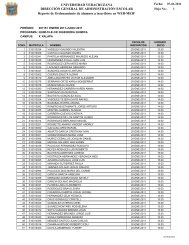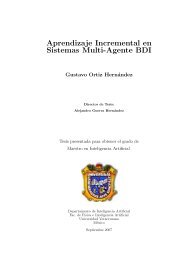Understanding the Software Options
Understanding the Software Options
Understanding the Software Options
Create successful ePaper yourself
Turn your PDF publications into a flip-book with our unique Google optimized e-Paper software.
TABLE 5. PURCHASE COST (C PCS) OF PUMPS<br />
Centrifugal pumps CapCost DFP CCEP<br />
Compressors<br />
Major compressor types are trunkpiston<br />
and crosshead reciprocating<br />
compressors, diaphragm compressors,<br />
centrifugal compressors and axial<br />
compressors. Case studies 4–7 involve<br />
compressors, and purchase costs of<br />
<strong>the</strong>se compressors at base conditions<br />
are presented in Table 2. Total module<br />
cost is shown in online table I.<br />
In <strong>the</strong>se and subsequent tables, <strong>the</strong><br />
cost estimate by CapCost is given, and<br />
<strong>the</strong> cost estimate by o<strong>the</strong>r methods is<br />
expressed as <strong>the</strong> percent difference<br />
from that by CapCost, such that ∆ =<br />
100 × (cost using o<strong>the</strong>r method – cost<br />
using CapCost) / cost using CapCost).<br />
Hence, a positive (or negative) ∆<br />
value means <strong>the</strong> cost estimate by that<br />
method is more (or less) than that determined<br />
by CapCost.<br />
Results in Table 2 indicate that compressor<br />
purchase cost estimates by<br />
CapCost, CCEP and AspenPEA are<br />
comparable, while <strong>the</strong> purchase costs<br />
given by EconExpert increase very<br />
fast with increasing size. In fact, DFP<br />
gives a very high cost compared to all<br />
o<strong>the</strong>r programs, which is mainly due to<br />
<strong>the</strong> cost equation given in Ref. 2. From<br />
Econ-<br />
Expert<br />
Aspen-<br />
PEA<br />
Power, kW Material CPCS ∆% ∆% ∆% ∆%<br />
CS4-P-101 0.3 CS 3,554* 152% 50%* 7% 55%<br />
CS5-P-104 0.38 CS 3,554* 156%* 49%* 14%* 57%*<br />
CS6-P-101 0.46 CS 3,554* 152%* 62%* 21% 57%<br />
CS5-P-105 0.75 CS 3,554 165% 46% 39% 60%<br />
CS2-P-102 1.12 CS 3,577 164% 48%* 57% 35%<br />
CS1-P-102 1.7 CS 3,726 165% 27%* 73% 53%<br />
CS4-P-102 1.7 CS 3,726 110% 46%* 73% 53%<br />
CS5-P-102/103 2 CS 3,807 166% 54%* 79% 50%<br />
CS2-P-101 2.24 CS 3,876 176% 28%* 83% 37%<br />
CS5-P-106 2.65 CS 3,979 209% 53% 89% 76%<br />
CS1-P-101 2.8 CS 4,025 251% 26% 91% 89%<br />
CS6-P-102 5.84 CS 4,807 297% 120% 110% 123%<br />
CS5-P-101 6.4 CS 4,934 289% 75% 112% 107%<br />
CS1-P-103 24 CS 8,257 204% 24% 117% 10%<br />
CS4-P-103 0.5 SS 3,554* 146% 59%* 24% 57%<br />
CS6-P-105 1.08 SS 3,565 143% 223% 56% 57%<br />
CS7-P-101 2.3 SS 3,887 163% 51%* 84% 50%<br />
CS6-P-106 3.69 SS 4,267 145% 294% 99% 132%<br />
CS6-P-104 10.4 SS 5,808 438% 140% 118% 58%<br />
Reciprocating pumps<br />
CS3-P-104 0.2 CS 7,659 n/a +<br />
–25%* 11% –9%*<br />
CS3-P-105 0.24 CS 7,613 n/a +<br />
–24%* 11% –8%*<br />
CS3-P-103 0.6 CS 9,258 n/a +<br />
–55% 22% –24%*<br />
CS3-P-101 22.4 CS 47,380 n/a +<br />
–21% 22% –38%*<br />
CS3-P-102 29.6 CS 57,500 n/a +<br />
–35% 22% –49%*<br />
CS6-P-103 0.16 SS 7,176 n/a +<br />
–29%* 4% –3%*<br />
Diaphragm pumps<br />
CS7-P-105 1 SS 10,730 n/a +<br />
45%* 26% –50%<br />
CS7-P-103 1.9 SS 13,455 n/a +<br />
182%* 27% –50%<br />
CS7-P-102 3.7 SS 17,710 n/a +<br />
–36% 27% –51%<br />
CS7-P-104 60 SS 95,105 n/a +<br />
17% 25% –87%<br />
* cost of minimum size as size is less than <strong>the</strong> minimum size<br />
+ not available in this program and so taken from ano<strong>the</strong>r program<br />
this equation, even <strong>the</strong> lower limit<br />
(power of 75 kW) gives a cost as high<br />
as $714,050. Such a high cost may be<br />
due to <strong>the</strong> data source for calculation<br />
of empirical constants. Differences in<br />
total module cost of compressors by different<br />
programs are larger than those<br />
in purchase costs (Table online), which<br />
is due to differences in installation and<br />
o<strong>the</strong>r factors used for C TM.<br />
Heat exchangers<br />
Common heat-exchanger types are<br />
shell-and-tube, double-pipe, air-cooled<br />
fin fan, and compact heat exchangers,<br />
including plate-and-frame and spiral<br />
plate types. Because heat exchangers<br />
are common, <strong>the</strong> data available from<br />
vendors and o<strong>the</strong>r sources are voluminous.<br />
The wealth of data results in<br />
relatively more-accurate cost estimation.<br />
For example, <strong>the</strong> purchase cost<br />
and total module costs of floatinghead<br />
and fixed-head heat exchangers<br />
predicted by all programs are comparable,<br />
with somewhat lower cost<br />
by CCEP and EconExpert (Table 3).<br />
For kettle reboilers, CapCost predicts<br />
50 to 80% higher purchase and total<br />
module costs than <strong>the</strong> o<strong>the</strong>r four pro-<br />
grams. For double-pipe heat exchangers,<br />
all programs predict comparable<br />
purchase cost. However, AspenPEA<br />
predicted a total module cost three<br />
times that by CapCost (online table<br />
II). The most significant factor contributing<br />
to <strong>the</strong> high total module cost<br />
in AspenPEA is <strong>the</strong> piping cost. While<br />
o<strong>the</strong>r programs calculate piping cost<br />
as a small fraction of purchase cost,<br />
AspenPEA model calculates piping<br />
cost based on respective equipment.<br />
For double-pipe heat exchangers,<br />
<strong>the</strong> piping cost is around three times<br />
<strong>the</strong> purchase cost, which contributes<br />
10×C PCS to C TM.<br />
Figure 1 shows <strong>the</strong> total module cost<br />
of floating-head heat exchangers calculated<br />
in all five programs as a function<br />
of heat transfer area. Since only <strong>the</strong><br />
U-tube shell-and-tube heat exchanger<br />
cost equation is given in Ref. 2, <strong>the</strong> DFP<br />
estimate in Figure 1 is for this type.<br />
Since floating-head heat exchangers<br />
are generally costlier than <strong>the</strong> U-tube<br />
type, <strong>the</strong> floating-head heat exchanger<br />
cost by DFP is expected to be slightly<br />
higher than that in Figure 1.<br />
For smaller heat transfer areas (up<br />
to 400 m 2 ), all five programs predict<br />
total module cost for floating-head exchangers<br />
with less than 50% deviation<br />
using <strong>the</strong> CapCost value as a reference.<br />
As <strong>the</strong> area increases, <strong>the</strong> deviations<br />
become more significant. In <strong>the</strong> seven<br />
case studies, many of <strong>the</strong> floating-head<br />
heat exchangers have areas below 400<br />
m 2 . Hence, all five programs predicted<br />
similar costs. However, when <strong>the</strong> heat<br />
transfer area is large, CapCost and<br />
DFP predict a relatively higher cost<br />
than <strong>the</strong> o<strong>the</strong>r programs.<br />
Figure 2 shows <strong>the</strong> variation in <strong>the</strong><br />
total module cost of fixed-head heat<br />
exchangers calculated by all five programs,<br />
with heat transfer area. Since<br />
only <strong>the</strong> U-tube shell-and-tube heat<br />
exchanger cost equation is given in<br />
Ref. [2], <strong>the</strong> DFP estimate in Figure<br />
1 is for this type. CCEP and Econ-<br />
Expert predict lower costs than <strong>the</strong><br />
o<strong>the</strong>r three programs for all sizes of<br />
fixed-head heat exchanger. However,<br />
for smaller areas, (up to 300 m 2 ) <strong>the</strong><br />
percent deviation is relatively small.<br />
In <strong>the</strong> case studies, most of <strong>the</strong> fixedhead<br />
heat exchangers have areas<br />
below 300 m 2 . Hence, all five programs<br />
predicted a similar cost. As <strong>the</strong> area<br />
CHEMICAL ENGINEERING WWW.CHE.COM AUGUST 2011 25



